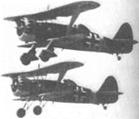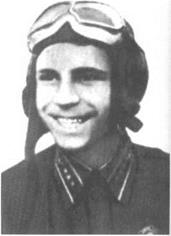Mud and Shturmoviks
|
B |
y late October 1941, both sides had virtually exhausted their first-line strength. Having obliterated practically the entire Red Army in the Moscow sector, the worn-down units of Generalfeldmarschall Fedor von Bock’s Army Group Center had then gotten stuck in thick mud. Luftflotte 2, supporting the Moscow offensive, was at the end of its tether.
According to Soviet sources, five hundred German planes were destroyed during the air-base raids between October 11 and 18.10 This figure has absolutely nothing in common with reality and was probably aimed at covering up the dismal state of the Soviet front during this period of the war. Nevertheless, the Soviets noted a considerable reduction in the enemy’s presence in the air during the latter half of October. The authoritative Soviet Air Force in World War Two states: “As the result of the blow – against enemy aircraft both on the ground and in the air, the effectiveness of enemy air power in the zone of the Western Front was reduced by three-fourths.”11 This observation was true, but the main reason was the general war situation.
Luftflotte 2 was successively weakened, but not only through accumulated losses and logistical problems. New – critical situations in other w’ar theaters forced the Germans to divide their forces. Late in October and early in November, the entire Fliegerkorps II, including half the units in Luftflotte 2, received orders to transfer to the Mediterranean area. British naval and air units operating from Malta were threatening to completely sever the seaborne lifeline to General Erwin Rommel’s Afrikakorps in North Africa. A radical strengthening of the Luftw-affe in this area was imperative. Thus five
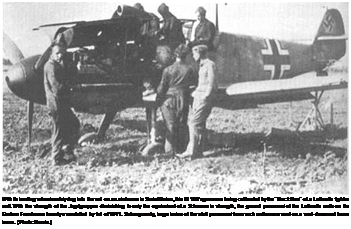 |
veteran Kampfgruppen, one Stukagruppc, and two Jagdgruppen left the Eastern Front.
Next, having suffered twenty-seven combat losses since June 22, KG 2 was withdrawn from the Eastern Front on November 1 to participate in a revived air offensive against the British Isles. Further, increasing resistance in the air in the Leningrad sector led to the transfer of I./JG 51 to Luftflotte 1. Other units, including I. and lli./JG.3, were completely worn down and had to be pulled out of combat for rest and recuperation.
Of nine Jagdgruppen supporting Army Group Center at the onset of Operation Typhoon, only five—II., III., and IV./JG 51, and I. and II./JG 52—remained to take part in the final offensive against the Soviet capital. After a month, the Luftwaffe could muster no more than fifty to a hundred fighters to fend off the increasing numbers of Soviet aircraft deployed against German ground troops in this area. In fact, one-quarter of the
personnel in JG 51 were sent on home leave in the beginning of November—simply because the small number of operational aircraft did not require a full personnel staff.12
On top of all these disturbing and disheartening elements were the effects from deteriorating weather conditions. The historians Jochen Prien and Gerhard Stemmer describe Orel Airdrome, the main Luftwaffe air base at the Moscow front during this time, as “a totally soggy and bottomless field.”1 ’
Meanwhile, strong Soviet reinforcements were pouring into the area. Almost without any interference from the Luftwaffe, General Armii Georgiy Zhukov was able to rebuild the Moscow’ defense forces in an astound – ingly short span of time. New recruits arrived, as did army divisions from the Far East. The latter had defeated the Japanese at Khalkhin-Gol two years earlier, and they were convinced that they would do the same to the Ger
mans outside Moscow. The high morale of these soldiers was sorely needed, and soon it inspired the men of other units. Most of these transports managed to reach the front without any interruption from enemy aircraft, although not undetected. As German historian Cajus Bekker points out: “In these days, long-range reconnaissance air crews of Luftflotte 2 reported large-scale transport movements on the railways converging on the capital from the east, especially at Gorkiy and Yaroslavl.”14 In fact, one of the main reasons behind the Soviet airbase offensive in October had been an assumption by the Stavka that the Luftwaffe was planning massive strategic air raids. This fear had been triggered by the raid in which three He Ills of 9./KG 55 Greif destroyed the tank factory at Kramatorskaya on the night of October 6, 1941. But the Stavka’s anxiety’ was without basis.
The Luftwaffe launched a few sporadic strategic air raids on the Eastern Front during the war, but in general, the main emphasis of the Kampfgeschwader in the USSR lay on tactical support, often even close support directly at the front lines. This was the Luftwaffe’s main doctrinal basis, and it would remain so during the entire war. Herbert Wittmann, w’ho flew an He 111 as Hauptmann and commander of the Stabsstaffel of KG 53 during this time, realized this fundamental weakness, as did many Luftwaffe airmen: “Why are we not sent against the enemy’s rear area? We find it incredible. It was wrong to concentrate on tactical close-support missions. It would have been tactically more sound if we had been launched with all force against railway stations, airfields, depots, industrial plants, etc., instead of bombing artillery positions, tank concentrations, and bridgeheads in the front area.”15
Much has been said and written concerning the lack of a German strategic bomber fleet. But this “what if” disregards the fact that the whole Blitzkrieg concept originated from Germany’s economic situation—mainly its lack of strategic raw materials—which provided no alternative beyond a short and decisive war. Hence, to lay full weight on tactical missions for the bomber force was, after all, most rational from the perspective of Germany’s prime strategic imperative.
The decimated WS units in this area also received strong reinforcements, including two Aviadivizii from WS-Northwestern Front, one BAP equipped with the new Pe-2 bombers, two Shturmovik regiments, five aviation regiments from 6 RAG, a light-bomber regiment flown by instructors and trainees from flight training schools, and even SB and TB-3 regiments brought in from the Central Asian Military District.
While the Luftwaffe operated under primitive conditions, entrapped in a logistical nightmare, the Soviets enjoyed the advantage of fighting at the nexus of all Soviet rail and road communications. Also, a chain of well-equipped, AAA-protected air bases stood at the disposal of Soviet air units.
During the lull before the battle for Moscow, the maintenance crews of the VVS made a feverish attempt to improve the strength of the air units. Brigadnyy Inzhener T. G. Cherepov, in charge of ground maintenance of the Moscow PVO air units, formed thirty-six mobile assembly plants. During the battle for Moscow these units assembled 150 new aircraft at the front and repaired 250 damaged planes. Due to this improvement in ground maintenance, Mayor Fyodor Prutskov’s 16IAP, 6 IAK/PVO was able to carry out 172 ground-attack missions in October 1941, claiming the destruction of 231 trucks, 18 tanks, and 6 bridges and river crossings.
In the days after the encirclement battles at Vyazma and Bryansk, the German situation deteriorated day by day. A gradually mounting resistance was encountered— in the air as well as on the ground. Around Teploye, some thirty-seven miles south of Tula, two Soviet cavalry’ divisions and five infantry divisions, plus one armored brigade, suddenly threatened to cut off the Second Panzer Army. While the German tanks had difficulties moving in the deep mud, the Soviets deployed T-34 tanks, which had been designed for such conditions.
The Luftwaffe was alerted, and even though the weather was so bad that the aircraft ran the risk of colliding with trees on the many small hills in the area, a large number of bombers was deployed in treetop-level attacks. Despite heavy losses, the German bombers managed to destroy several T-34s and forced the Soviets to withdraw.
Northwest of Moscow, a Soviet counteroffensive was launched against the German Ninth Army and the Third Panzer Army in the Kalinin area. Directly from the Kalinin factories, a strong workers’ militia reminiscent of the Russian Civil War was thrown against the invaders. As a result, the 1st Panzer Division became surrounded in this sector on October 19.
As the pressure at Kalinin increased, the commander of Fliegerkorps VIII decided to redeploy strong Luftwaffe forces to Kalinin Airdrome. Covered by the Bf 109s of 1. and 1I./JG 52, the Ju 87s of Stab and l./StG 2, and the ground-attack aircraft of Hauptmann Otto Weiss’s I1.(S)/ LG 2 were dispatched from Kalinin on October 21. Launching relentless dive-bombings and low-level attacks during the following days, they managed to break up the Soviet forces that had isolated the 1st Panzer Division. The bloody losses inflicted on the Red Army by the Hs 123 biplanes under the command of Hauptmann Weiss rendered this able commander the honorary nickname “The Lion of Kalinin” among the German ground troops. Wearing the Knight’s Cross since the Battle of France in
1940, Otto Weiss was awarded the Oak Leaves as the first Schlachtflieger of the Luftwaffe on December 31,
1941. Weiss was the best-known Schlachtflieger of the war, but he was also a very harsh and often ruthlessly demanding commander. Among some of his subordinates he became known by the unflattering nickname “Weiss the Butcher.”16
On October 22 the Luftwaffe attempted to raid Moscow’ in broad daylight. Due to improved weather conditions, Luftflotte 2 managed to launch 481 sorties
|
|
The Hs 123 ground-attack biplane to a large extent earned a place on the | fighting front as the Luftwaffe’s last resort during the difficult Fall of 1941 3 on the Eastern Front. Due to its wide stance and sturdy undercarriage ti® j Hs 123 was able to operate from loamy airfields where other aircraft simply! got stuck in the mud. (Photo: Bundesarchiv.)
this day. But Soviet fighter opposition was so intense I that no bombers were able to penetrate to the Soviet! capital.
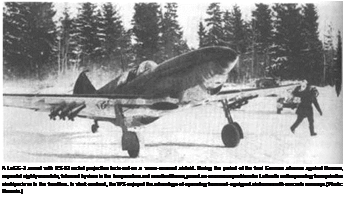 |
Unteroffizier Walter Todt of l./JG 52 recalls "the | final battle” in the air over the approaches to the Soviet!
capital: “Just as we had left the second antiaircraft barrage behind us, Ratas and MiGs attacked our formations from all directions. A fierce dogfight followed. The AAA stopped firing. The fighter attack came as a total surprise, and the aerial combat developed into a chaotic ‘catch – as-catch-can.’ All hell broke loose on the R/T: ‘Break off!’ ‘There’s one on your tail!’ ‘Victory!’ ‘Did you see that?’ ‘Watch out!’ etc., etc. Several Stukas did not return from this mission. Later 1 noted that no more daylight raids were made against Moscow following this combat.’1′
34IAP alone put up fifty-nine sorties on October 22 and claimed twelve enemy aircraft shot down. The heavy losses forced the Luftwaffe to refrain from further attempts to attack Moscow in daylight..
Counted among the victims on October 22 was Oberfeldwebel Robert Fuchs, who, with twenty-three kills, was the most successful pilot of 7./JG 51 following the death of Leutnant Joachim Hacker ten days earlier.
The next day, 7./JG 51 lost another of its few’ remaining Bf 109s when Unteroffizier Giinther Schack had to bail out of his burning plane, and in l./JG 51, Oberfeldwebel Heinz Schawaller, credited with twelve victories, was killed in combat. Also on October 23, KG 53 lost five He 111 crews on one mission, including the commanders of both 7. and 8. Staffel, Oberleutnant Oswald Gabler and Major Willi Hasten18
The toughest adversaries the Luftwaffe faced in air combat were the crack fighter units of the Moscow PVO. Starshiy Leytenant Gerasim Grigoryev of 178 IAP scored his first victory, an He 111, on October 24. 178 IAP was equipped with LaGG-3s, which by all accounts was not a very successful fighter. But Grigoryev had learned to handle the weaknesses of the LaGG-3. Realizing that it was a “slow climber," he utilized a superior flight altitude to jump and down one German aircraft after another.
During another encounter on October 24, six MiG – 3s of 16 IAP reportedly shot down six German planes out of a formation of eighteen Ju 88s escorted by ten Bf 109s in the Naro-Fominsk area. One of the MiG pilots, Mladshiy Leytenant Ivan Golubin, got into a cloud following a combat turn during this melee. As he emerged into clear sky, he saw a lone Ju 88 in front of him. He gave it a quick burst, and the German bomber started to smoke. Golubin followed the Junkers, which attempted to escape in a dive, and kept firing at his prey until it finally tore into the ground. This was his first victory.’.
During the following two months, Golubin achieved another six personal and two shared victories in only nine combats. (Ivan Golubin and a few other skilled pilots in 16 IAP became famous for specializing in the use of RS-82 rockets in air combat. This unit claimed to have brought down six enemy aircraft with RS-82s in October 1941.)
But the Soviets also paid a high price for their victories on October 24. In 16 LAP, two pilots were shot down and had to bail out. A third pilot was wounded, and the MiG-3 piloted by Leytenant Aleksandr Suprun, the brother of the famous ace Podpolkovnik Stepan Suprun, was severely damaged, returning to base with 118 bullet holes. Stab/JG 3 claimed five MiG-3s this day. With one of them, the Geschwaderkommodore Major Gunther Liitzow became the second German fighter pilot to surpass the 100-victory mark.
On October 27, the famous “night-taraner” of 177 IAP, Mladshiy Leytenant Viktor Talalikhin, a Hero of the Soviet Union, was killed in action, having achieved a total of five victories including the famous night taran over Moscow in August 1941. On that same day, the Staffelkapitan of 7./JG 51, Oberleutnant Herbert Wehnelt, bounced a group of ll-2s that was beating up a German tank column. With a total of nineteen kills to his credit, Wehnelt belonged to the JG 51 elite, and especially of 7. Staffel. Despite having his wingman shot dow’n—for the second time in two weeks—Oberleutnant Wehnelt attempted to pursue a pair of retreating Shturmoviks on his own. As W’ehnclt aimed at one of the Shturmoviks, a second 11-2 sprayed the German fighter with bullets. With its rudders shot to pieces, the Bf 109 was seen diving into a small wood. The badly wounded Wehnelt was eventually rescued. Thus the Soviet fliers had struck hard against the 7. Staffel of JG 51, depriving it of three aces—Leutnant Joachim Hacker on October 12, Oberfeldwebel Robert Fuchs on October 22, and Oberleutnant Herbert Wehnelt on the October 17. The morale among the survivors in 7./JG 51 dropped considerably. This can be read in the results table of the Staffel, which shows only four victory claims for the whole November-December 1941 period.
At Kalinin, from which Hauptmann Otto Weiss directed his pilots into combat, the German airfield proved to be a trap in itself. The Hs 123s were soon involved in self-defense missions against Soviet tanks attacking the base. Once again, II.(S)/LG 2 managed to ward off the ground attacks, but its pilots could not prevent Soviet artillery, hidden in the deep woods, from subjecting the airfield to constant shelling. Oberfeldwebel Kurt Warmbold, a member of the ground crew’ of I./JG 52 in Kalinin, wrote in his diary: “October 29: This is the darkest day during our entire Eastern Campaign. The Russians have covered our airfield with systematic artillery shelling since early this morning…. The Gruppe Weiss lost seventeen aircraft in today’s heavy shelling.”19
Martin Reiner, who led a draft of groundcrewmen from StG 2 committed to ground combat at Kalinin Airdrome, later recalled: “A large number of dead soldiers, Germans and Russians next to each other, lay on both sides of the road, just as they had fallen. Russian women searched among the dead for their beloved husbands, who recently had been mobilized for the defense fight from the factories in Kalinin. Several were in civilian
clothes or half uniformed—— There was no time to bury
the dead.”20
The deteriorating state of the Luftwaffe was reflected in the mounting successes among the VVS fighter pilots. 16 LAP’s Mladshiy Leytenant Ivan Golubin had his most successful day on October 29, when he claimed one Ju 87 and one Bf 109 in a morning melee, followed by two Bf 109s near Vorob’i at noon. On that day the Luftwaffe registered a total of nineteen German aircraft destroyed or heavily damaged in combat on the Eastern Front. One of the losses, a Bf 110 of 3./ZG 26, might be the Bf 110 claimed taraned by Mladshiy Leytenant Boris Kovzan of 42 1AP. After “cutting down” the German heavy fighter with the propeller of his MiG-3, Kovzan made a forced landing near a collective farm. There he actually repaired the damaged propeller in the farm’s forge and managed to fly back to base. At the base, his commamnder, Kapitan Georgiy Zimin, established that Kovzan had expended only half of his ammuniton against the Bf 110. Asked why he had taraned, Kovzan shamefacedly admitted, ‘1 don’t know how to shoot.” Kovzan, who had previously been a liaison pilot flying U-2s, had neither flown a fighter nor practiced aerial gunnery before being posted to 42 IAP. This story clearly portrays the inadequate standard of VVS airmen during the early years of the war, not to mention the do-or-die mentality that saved the USSR in this critical time. Boris Kovzan not only survived this air – to-air ramming, he emerged as the “top taraner” of the entire war, with four successful aerial rammings.
|
|
Boris Kovzan would develop into one of the legendary Soviet fighter pilots of World War II. When posted to 42 IAP as a Mladshiy Leytenant, he had never received any gunnery training. His first victory, on October 29,1941, was achieved through ramming. A month later, Kovzan was shot down, but he once again survived unhurt. On February 22 and June 8,1942, Kovzan performed his second and third tarans. Following his fourth taran— during which Kovzan suffered severe injuries—he was appointed Hero of the Soviet Union on August 24,1943. With this, Boris Kovzan became the highest scoring air-to-air rammer of World War II. He passed away in Minsk on August 31,1985. (Photo: Zimin.)
Another taran claimed by the Soviets on October 29 also saw the pilot, 176 lAP’s Starshiy Leytenant Sergey Kotorov, survive.
Following the renewal of intense shelling on October 30, during which eight Bf 109s of II./JG 52 were put out of commission, the Germans decided to abandon the forward airfield at Kalinin. Kurt Warmbold wrote: “I couldn’t even finish loading all the equipment into one of the Ju 52s, because the pilot was in a hurry to take off due to the increasing artillery fire. 1 was very happy as the aircraft shortly afterward left the ground and within thirty minutes brought us to safety in Staritsa.”
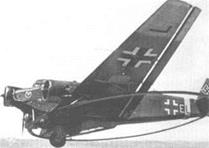
 During the hasty evacuation, one Ju 52 received a direct artillery hit and was completely burned out. Several others were damaged.
During the hasty evacuation, one Ju 52 received a direct artillery hit and was completely burned out. Several others were damaged.
Growing Soviet resistance and mounting losses put a strain on the German troops and airmen on the Eastern Front. As in the case of 7./JG 51,
Luftwaffe airmen manning all the units on the Eastern Front started to lose their self-confidence and fighting spirit. While some of the aces kept scoring, others showed alarming signs of battle fatigue, as pictured in the following account from JG 51: “These men no longer dared to fly over the front line. They had great respect for the fierce resistance put up by the rear gunners of the Russian bombers and turned away, having fired only a few bursts from a great distance. They would even, if possible, evade getting picked for a flight as soon as permission [for leave] was granted.”21
Four pilots of 16IAP—Leytenants Nikolay Semyonov and Aleksandr Suprun, and Mladshiy Leytenants Ivan Golubin and Ivan Shumilov—each claimed five to nine personal and shared victories between September 30 and October 31, 1941. The loss ratio of this unit can be read by the fact that the maintenance unit of the regiment restored forty-two damaged MiG-3s during October and November.
In total, WS-Western Front claimed to have shot down 120 German aircraft in October.
On November 6, 16 lAP’s Starshiy Leytenant Ivan Zabolotnyy fought a very difficult combat with a Ju 88, eventually bringing it down, but not before his own aircraft had sustained 127 bullet hits.22 That same day, a severe blow was struck against the German fighter units in this area when the commander of l./JG 52, Oberleutnant Karl-Heinz Leesmann, was shot down near Klin, northwest of Moscow. His staff Schwarm was returning from a combat sortie and had just begun landing when they came under heavy Soviet machine-gun fire. The lead Bf 109 was hit from below through the cock
pit. A bullet splintered the bones in Leesmann’s right forearm. He barely managed to land and never returned to the Eastern Front. As he was a Knight’s Cross holder and victor in thirty-two aerial combats, the loss of such an outstanding fighter pilot was irreplaceable. Nevertheless, the pilots of his Jagdgruppe took a bloody vengeance on the enemy, claiming thirty-five Soviet aircraft shot down from November 4 to 15.
On the Soviet side, Starshiy Leytenant Gerasim Grigoryev of 178 IAP bagged one Ju 88 on each on No vember 9, 15, and 27.
Even if increasing hardships and battle fatigue put a heavy strain on the Luftwaffe airmen at this time, the solid core of fighter aces remained a factor to be reckoned with, not least in Werner Molders’s old JG 51, which scored 289 victories during October 1941. The most successful individual pilot during this period was Oberfeldwebel Edmund Wagner of 9./JG 51, who claimed 22 kills in October. On one occasion Wagner was attacked by five Soviet fighters, of which he shot down four. Nevertheless, a total of fifty-seven victories, all but one against the WS, was not enough to spare Wagner. He was killed in air combat on November 13,
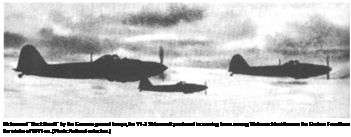 |
1941, while pursuing a formation of Pe-2s at treetop level over the front lines. His Bf 109 was raked by machine – gun fire from a Soviet rear gunner. The soldiers of a German antiaircraft battery1 watched as Wagner’s airplane plunged into the ground, exploding on impact and leaving a thick black cloud of smoke. The ace never had a chance.
Meanwhile, 11-2 Shturmoviks and other ground – attack aircraft fell upon the mired German invasion army. In an early account of the Red Air Force, Swedish Air Force General Stig Wennerstrom wrote: "It was mainly due to the performances of this effective ground-attack aircraft [the 11-2) that the Russians were able to make use of the German dilemma outside Moscow in 1941, as their ‘summer army’ was halted by the sudden and unexpected cold spell. Their army was stuck and became subject to incessant attacks from the aggressive 11-2 airmen. According to Russian reports, they destroyed 406 German tanks, about 2,000 motor vehicles, and 42 artillery pieces during the period November 1-November 11.
The assessment of the role played by the Shturmoviks
during the Battle of Moscow, however, has to be regarded with care. In general, there is something like a Soviet “Shturmovik myth” surrounding this battle. In fact, the actual number of ll-2s remained relatively low during the winter of 1941-42.
The fighter aviation regiments still carried the main burden of tactical air support, even if Shturmoviks undoubtedly accomplished some of the most successful air strikes.
Historian Albert Seaton gives the following account from the point of view of the German soldiers harassed by the Soviet pilots during these difficult days: “Infantry companies, twenty’ men strong, led by second lieutenants or sergeants, were bearded and filthy, not having bathed or changed their clothes for months. Tormented by lice, they lay all day cramped and stiff in the narrow weapons pits filled with water, their feet so cold that they had lost all feeling. Sickness and cold caused more casualties than enemy action. Rain fell incessantly and the Luftwaffe seemed unable to cope with the Red Air Force fighters and bombers which dropped out of the low clouds, bombing and machine gunning.”24











